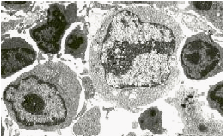|
1. Anderson, A. O., N. D. Anderson. 1975. Studies on the structure and permeability of the microvasculature in normal rat lymph nodes. Amer. J. Path. 80:387-418.
2. Anderson, A. O. and N. D. Anderson. 1976. Lymphocyte emigration from high endothelial venules in rat lymph nodes. Immunology 31:731-748.
3. Ebnet, K., E.P. Kaldjian, A.O. Anderson, and S. Shaw, 1996, Orchestrated Information Transfer Underlying Leukocyte Endothelial Interactions. Annu. Rev. Immunol. 14:155-177.
4. Gretz, J.E., E.P. Kaldjian, A.O. Anderson, and S. Shaw, 1996,Sophisticated strategies for information encounter in the lymph node: the reticular network as a conduit of soluble information and a highway for cell traffic. J.Immunol. 157:495-499.
5. Gretz, J.E., A.O. Anderson, and S. Shaw, 1997 "Cords, Channels, Corridors, and Conduits: Critical architectural elements facilitating cell interactions in the lymph node cortex." Immunol. Rev. 156:11-24
|
|





